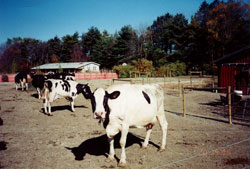Happy Cows, Happy Creeks: Agriculture and our Watersheds
By Lisa Flinn, Crawford County Conservation District Intern
 From stream-bank fencing to barn-yard stabilization to milk-house collection systems, farmers have come a long way in promoting healthy watersheds through the use of Best Management Practices (BMPs). Local farmers speak out about the need for water quality and the responsibility everyone shares in maintaining water standards. Frank Field, a dairy farmer in Springboro says, “If the American people want clean water, they have to do their part too. That way it’s a win-win situation, but if it’s all on the farmers’ shoulders, it’s uneconomical for us.” According to National Land Cover Data (NLCD), agricultural lands account for 37.4% of land use in Crawford County, making proper farming practices crucial.
From stream-bank fencing to barn-yard stabilization to milk-house collection systems, farmers have come a long way in promoting healthy watersheds through the use of Best Management Practices (BMPs). Local farmers speak out about the need for water quality and the responsibility everyone shares in maintaining water standards. Frank Field, a dairy farmer in Springboro says, “If the American people want clean water, they have to do their part too. That way it’s a win-win situation, but if it’s all on the farmers’ shoulders, it’s uneconomical for us.” According to National Land Cover Data (NLCD), agricultural lands account for 37.4% of land use in Crawford County, making proper farming practices crucial.
There are several potential threats to local streams and other waterways from agricultural runoff containing fertilizers, pesticides and sediment. Rainwater runs over fields saturated with fertilizers and pesticides and carries the “run-off” to the closest waterway for disposal. The added nutrients from fertilizers disturb the natural water chemistry leading to eutrophication – an explosive growth of algae and plants. The chemicals in pesticides in the runoff could be potentially toxic to aquatic life. Ground water contamination is also a potential threat, since excess pesticides and fertilizers can leach through soil into the water table. It just makes economic sense to want to keep fertilizer and pesticides on the fields for which it was intended.
The third typical source of agricultural non-point pollution is sedimentation. According to the DEP, cropland contributes 1, 424 pounds of sediment per acre each year. The lack of riparian buffers or forest cover beside waterways aids sediment overload in streams, since stream-bank stability is maintained through root systems. Without the riparian buffer, soil has nothing to cling to and can be washed directly into waterways. Similarly, a study in North Carolina concluded that riparian buffers have the ability to capture up to 90% of sediment in surface water. Phosphates, nitrates, and toxins found in pesticides and fertilizer runoff are also caught by riparian buffers before they enter the waterway.
Best Management Practices were created to find the “best” way to help the environment, while looking out for the economic interests of the landowner. Field recently restricted cow access to his creek and stabilized the land surrounding the barn using concrete bunkers. Field comments, “If it had not been for the planning and design of the Conservation District and the National Resource Conservation Service (NRCS) and the funding through The French Creek Project, this would have never gotten done, because the income for farmers in not there.” By using this particular BMP, Field has reduced excess nutrients and sediment from entering the creek, without a financial headache.
Like Field, the folks at Bryer Farm in Linesville decided to use BMPs because of their close proximity to Pymatuning Lake. They agreed, “You don’t want to destroy it [lake] because it is all a matter of respect for the people around us.”
Just as farmers and landowners are looking out for water quality, local residents or “city folk” can help the farmers by respecting their crops and property. The Bryers noted, “Beer cans thrown in the fields are getting mixed in with feed for the cows. So, instead of focusing on our own runoff, we have to worry about other people’s waste.” Click Here to watch a video on what Crawford County farmers are doing to prevent non-point source pollution. Click Here for more information on Agricultural Best Management Practice programs in Crawford County.

